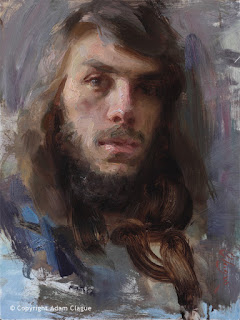Finding your artistic voice is like walking a tightrope. On one side of the tightrope is the Chasm of Static Rendering. On the other side is the Abyss of Unbridled Creativity.
If you traverse the tightrope chanting “Paint what you see, paint what you see,” you can enter Gotta-Get-This-Right Mode and topple into the Chasm of Static Rendering. However, if you forget to "paint what you see" altogether, you can enter There-Are-No-Rules-So-I Can-Do-Whatever-My-Creative-Whims-Tell-Me Mode. Accuracy is lost, and you plummet into the Abyss of Unbridled Creativity!
How to Keep Your Balance
You need a balancing pole. One end of this pole is weighted with your creative vision. The other end is weighted with accuracy.
By "accuracy," I mean painting your subject faithfully, according to the 5 Fundamentals (See 5 Reasons Your Painting Doesn't Look Like Your Subject). I consider these 5 Fundamentals to be the foundation upon which good representational art is built. So accuracy is important! But it's not everything. It is also important to allow your work to be influenced by your creative vision.
By "creative vision," I mean having a relatively clear mental image of how you want your painting to look. Developing your creative vision takes time, and that's OK—if painting weren't a journey, it wouldn't be exciting! Fortunately, there are practices that can help you develop your creative vision. Here are two that have helped me the most:
1. Study the work of great artists
to learn how they solved problems
to learn how they solved problems
- Observe their work at museums and galleries.
- Paint copies of their work (Doing this gave me some of my best growth as an artist).
- Merely copying another artist's style is not the ultimate goal. Instead, study their work to get
ideas for how you might solve similar problems in your own work.
2. Ask yourself questions like these:
- What subject(s) inspire me the most?
- How can I make the best picture?
- How do I want this to look?
- "Do not ask yourself, 'What do I see?' Rather ask, 'What do I see?' " (Richard Schmid, Alla Prima: Everything I Know About Painting)
The First Step Toward
Finding Your Artistic Voice

The first step toward finding your artistic voice is simply venturing out onto that tightrope. At first, you'll feel a bit wobbly. Sometimes you'll fall—I do frequently! But eventually, as you take one step at a time, you'll pick up speed and the balancing will become easier.
Again, always balance yourself with accuracy and creative vision. The more you make decisions based on both accuracy and creative vision, the more your unique voice will develop.
Walking a tightrope is a frightening illustration (sorry about that). However, finding your artistic voice is nothing to worry about. It will develop naturally over time. And when it does, it cannot help but be unique to you. After all, each of us is specially hand-crafted by the Master Artist. Your voice is merely an extension of who you are—a beautifully unique person!
So venture out onto that tightrope—I can't wait to see what you'll paint!
Learn to Paint Dynamic
Portraits & Figures In Oil
Online Video Course
(Click image to view full-size)
Remember, one end of your balancing pole needs to be weighted with creative vision and the other with accuracy. This lesson contained steps to develop your creative vision, but there’s much more to talk about when it comes to accuracy. There’s just not room in these blog lessons to completely unpack all the vital principles that will enable you to capture the beauty of your subjects. That’s why I spent 3 1/2 years developing the Online Video Course. With 52+ lessons, including over 10 hours of videos, I'll show you how I communicate the beauty of portraits and figures from start to finish.
Access to the course will become available for purchase on October 7, 2019, but you can start the course today for FREE! For more information, please click the button below.
|
The next Free Art Lesson will start a series of lessons on our materials. You may already know that Andrea and I love using Rosemary & Co. brushes. But next time, I'll share specifically which brushes we use and why in Our Favorite Brushes and How We Use Them.
See you there!
—Adam









































